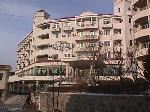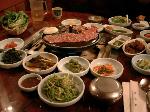- Getting around Lijiang. Dont stay in the Old Towns more than 2 days, there is nothing to do. KRISS Oct 9, 2013 05:46
- 2013 Beijing Temple Fair BENNYLAU Feb 26, 2013 03:29
- Malaysian traveling from KUL - LAX vis Shanghai PVG ZATI_DY Jan 3, 2013 20:15
A Korean Student in Dalian
- Views: 7508
- |Vote: 1 0
- |Add to Favorites
- |Recommend to Friends
Malan Guangchang
The channel of Dalian's dried-up Malan River runs right through the city, serving as a potent reminder that this was once a town with plentiful resources and a perfect natural environment. But Dalian has come to that point of development where things could go either way - as the population increases, the demand for water and other resources could become so great that the city will slowly become more and more polluted, or perhaps with some luck and some forward-thinking management, the city could put environmental controls in place that will not only restore water but also contribute to the stunning beautification works that have already made Dalian the most charming city in North China.
Out in Malan Guangchang (Malan Square), the out-of-the-way little suburb where the Teacher's University is located, it's unclear which path Dalian will follow. Although in other parts of town, scores of brand new, ambitious high-rises make Dalian's skyline look like something from the cover of a Science Fiction novel, here in Malan Square dusty broken pavements are teeming with merchants selling their wares from mobile carts stacked with produce, in a scene that could be taken out of any of China's less prosperous provincial towns. The pavement is littered with fruit peel discarded by careless student customers, and there is a steamy smell in the air from fried street snacks - in particular the chewy skewered squid that Dalian people love to ruin their teeth on.
But Malan Square has one feature not often seen in places like this in China - it's overrun with foreigners. The Liaoning Teacher's University has grown more and more successful in attracting students from abroad, and now the school's compliment of language students from all around the globe runs into some very profitable numbers. Dalian's location and environment make it particularly attractive for Japanese and Korean students, but increasingly African and European faces have become regular sights in the Malan Square markets at all times of the
day and night.
The campus has a large student dormitory that looks like a hotel, where the foreign students live with a little more privacy than do the Chinese students in their 6-8 person dormitories across the way. This arrangement is also a handy tip for travelling foreigners looking for budget accommodation, as cheap rooms for short-stay tourists are often available at the student dorms.
I was lucky, on a return trip to Dalian, to have received this tip from an old friend of mine from Korea who was studying at the university. Kim Bobae, who went by the equivalent Chinese name of Jin Baobei and the uncomfortable English name of Baby, had told me that there was a spare room close to hers and had already booked me to stay for a couple of days before I had arrived, which saved me the trouble of finding my own hotel.
Baby, the youngest of five daughters and most certainly the family treasure, as her Chinese name suggested, was looking forward to welcoming me into the life of foreign students at the University, and I was looking forward to it too. Language students in China are curiously innocent in their behaviour, no matter what country they are from - something about the sweet topics of conversation they enthusiastically discuss in their simple Mandarin is very appealing, and the times I have spent with foreign students have always been fun.
Korea Town
Although I'd lived for a long time in Dalian before, I'd never heard of Korea Town. Dalian has two famous streets that have cultural themes from different countries - the most famous being Russian Culture Street, which is situated not far away from the central train station at the bottom of Shanghai Road. The Russian Culture Street is a series of restored Russian colonial homes that have been painstakingly renovated to look like pastel palaces. Visitors to Russian Culture Street will find it hard to believe that the place is real - that is, until veering left or right from the main path, where they will find a host of amazing buildings in their untouched, decrepit condition - many housing several families in each former mansion.
The other street is Japanese Culture Street, which although marked on many maps is quite out of the way and extremely difficult to find. I remembered having tried once and taking half the morning - as even the locals in the area had trouble remembering exactly where it was, if they'd heard of it at all. When I found it, it turned out to be a very short lane of colourful Japanese restaurants, all built in similarly restored colonial homes from the time of Japanese occupation (which in Dalian lasted longer than just about anywhere else - 40 years).
Korea Town isn't on any Dalian Map, and it seems to be the kind of place you have to be Korean to know about. Baby had promised to show me the way and enjoy a fabulous Korean feast with me, and so we set off on a very long bus trip across town which led to the other socio-economic end of Dalian - the international hotels area around Gangwan Square, close to Dalian's harbour. This is the richest part of Dalian - originally constructed by the Japanese, the port is the focus of all Northeast Chinese sea trade. Despite Dalian's bitter feelings towards their former invaders from Japan, their business acumen has seen billions of dollars flow into the city from Japan, and even today Dalian (known as Dairen in Japanese and still referred to by that old colonial name) attracts thousands of Japanese fortune-seekers - not to mention language students.
We started opposite the Shangri-la hotel and worked our way through the side streets in the opposite direction. Taking a few unlikely turns, but still never getting too far away from the main road, we suddenly emerged in a small lane filled with Korean restaurants. Unlike the Japanese Culture town where the buildings are originally Japanese made, Korea Town is constructed expressly for the pleasure of the city's Korean population, which is just as blossoming as is the Japanese. I was thrilled to have a chance to be a member of this secret cabal - it was almost like visiting another country for the evening.
Ma-ko-le
It's often said that foreign students in China are wealthy, and it's kind of true, although that wealth is usually not their own but their parents', who have sent them overseas for a year in the hope of giving them a brighter future in Chinese business. Baby's family were far from rich, but they had saved enough so that their favourite daughter could experience something special that her older sisters had missed out on. She was hardly the kind of girl to flash a wad of 100 yuan bills from her father's account, but she was certainly not going to be stingy when it came to treating me to a real Korean dinner.
We chose the most Korean looking restaurant of the bunch, complete with sliding bamboo doors, shin-high tables, and plentiful vials of Korean alcohol. Baby ordered a massive feast and asked me if I was prepared to try a special Korean alcohol called - something I couldn't pronounce, but approximated as something like ma-ko-le.
Baby was at home with her shoes off, cross-legged at the short table opposite me. Her metal chopsticks smoothly negotiated the searing hot dishes, and I soon found myself chomping on delicious morsels prepared by genuine chefs with genuine ingredients. I cautiously tried the ma-ko-le and found it quite pleasant, seemingly mild with a slight fruit-juicy flavour. I asked Baby more about it, and was overheard by the Korean businessmen in the next room, whom we heard begin to discuss ma-ko-le themselves, ordering several bottles noisily.
The food was making me feel unexpectedly amazing, and I couldn't help but become very curious at the strange singing emanating from the neighbouring room - one particularly plastered soul was singing in weird mixtures of Chinese, Korean and English, improvising a melody on his personal friendship with ma-ko-le. I didn't understand how he could be so drunk on the stuff until I tried myself to stand up.
Ma-ko-le, whatever it really is, is a cunning brew. It's incredibly drinkable, but from the moment I stood up, I was entirely under its control - and Baby had obviously long since succumbed to the exotic pleasures of the juice, pulling at my sleeve pleading with me to take her dancing. I have no idea how or when, but somehow we paid the fabulous bill and made our way back to the Shangri-la.
In the front drive is a strange glass pyramid with stairs leading down to one of Dalian's premier disco joints called Banana. Banana was a wild dark cave with rippling blue laser beams - or perhaps neon lights - or both, for I was really only aware of being pulled into the crowds by an insistent Baby.
She had that typical long, straight, jet-black Korean hairstyle, and before long was shaking it expertly with a group of other Korean girls right across the room from me. I wasn't sure why I was by myself, but the Chinese businessmen who was toasting me was trying to get me to drink a bottle of beer, and I was refusing impolitely. One angry young male started threatening to punch me, until the businessman raised his hand, at which point the young guy began to bow humbly - "I'm sorry, Big Brother Li, please forgive me, I'm worthless...". His girlfriend, who was clearly paid for, was looking at me with candy eyes, and I finally decided I was in the wrong part of Dalian for the evening. All I remember of that night from that point on is walking along Dalian's brilliantly lit boulevards transfixed at the beauty of the city at night, and trying to hold Baby up as we tried to hail a taxi back to our far more casual temporary home at Malan Square.






 Copyright © 1998-2025 All rights reserved.
Copyright © 1998-2025 All rights reserved.